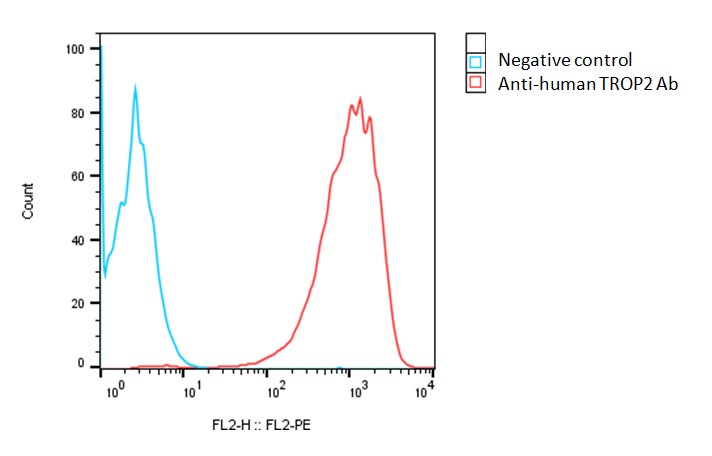
| Catalog Number | Product | Size | Price | |
|---|---|---|---|---|
| C3061 | Cynomolgus TROP2-CHO-K1 Stable Cell Line | 2 vials | $4950 | Order |
| Catalog Number | C3061 |
|---|---|
| Cell Line Name | Cynomolgus TROP2-CHO-K1 Stable Cell Line |
| Accession Number | XP_005543292.1 |
| Host Cell | Adherent CHO-K1 |
| Quantity | Two vials of frozen cells (2x106 per vial) |
| Culture Medium | DMEM with 10% FBS, 4 µg/ml puromycin |
| Freezing Medium | 90% FBS and 10% DMSO |
| Storage | Liquid nitrogen upon receipt |
| Product Datasheet: | Download PDF |
Detection of cynoTROP2 expression on cynoTROP2-CHO-K1 stable cells using a monoclonal antibody specific for human TROP2 (BioLegend, #363803)

TROP2, also known as TACSTD2 (tumor-associated calcium signal transducer 2), is a transmembrane glycoprotein that plays a significant role in cell adhesion, proliferation, and signal transduction. It acts as a cell surface receptor and is involved in diverse cellular processes such as cell growth, differentiation, and migration. TROP2 is also associated with epithelial-mesenchymal transition (EMT), a process involved in embryonic development and tumor metastasis. In terms of tissue expression, TROP2 is predominantly found in epithelial tissues. It is expressed in various organs, including the lung, breast, colon, pancreas, prostate, and ovary. TROP2 expression is particularly high in epithelial cells lining the gastrointestinal tract and the ducts of different glands. TROP2 has gained significant attention in the field of cancer research due to its dysregulation in various malignancies. Elevated TROP2 expression has been observed in several cancer types and has been associated with tumor progression, invasion, and poor prognosis. As a result, TROP2 has emerged as a potential therapeutic target for anticancer interventions.
Cubas R, Li M, Chen C, Yao Q. Trop2: a possible therapeutic target for late stage epithelial carcinomas. Biochim Biophys Acta. 1796(2):309-314. 2009.
Wang J, Day R, Dong Y, Weintraub SJ, Michel L. Identification of Trop-2 as an oncogene and an attractive therapeutic target in colon cancers. Mol Cancer Ther. 7(2):280-285. 2008.